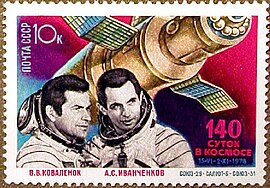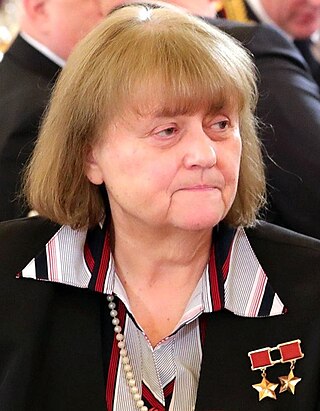
Svetlana Yevgenyevna Savitskaya is a Russian former aviator and Soviet cosmonaut who flew aboard Soyuz T-7 in 1982, becoming the second woman in space. On her 1984 Soyuz T-12 mission she became the first woman to fly to space twice, and the first woman to perform a spacewalk.
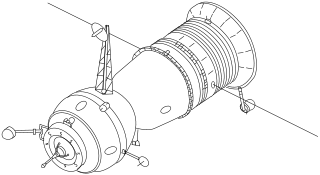
Soyuz 21 was a 1976 Soviet crewed mission to the Salyut 5 space station, the first of three flights to the station. The mission's objectives were mainly military in scope, but included other scientific work. The mission ended abruptly with cosmonauts Boris Volynov and Vitaly Zholobov returning to Earth after 49 days in orbit. The precise reason for the early end of the mission was the subject of much speculation, but was reported to be an emergency evacuation after the Salyut atmosphere developed an acrid odor.

Soyuz 29 was a 1978 crewed Soviet space mission to the Salyut 6 space station. It was the fifth mission, the fourth successful docking, and the second long-duration crew for the orbiting station. Commander Vladimir Kovalyonok and flight engineer Aleksandr Ivanchenkov established a new space-endurance record of 139 days.

Soyuz 14 was a July, 1974, crewed spaceflight to the Salyut 3 space station. Soyuz 14 is also the name given to the Soyuz spacecraft which was used to bring the cosmonauts to and from the station. The mission was part of the Soviet Union's Almaz program to evaluate the military applications of crew spaceflight. The mission's crew members were cosmonauts Pavel Popovich and Yuri Artyukhin. At the time, the military nature of this mission and the station itself were not acknowledged by Soviet authorities.

Vitaly Mikhaylovich Zholobov is a retired Soviet cosmonaut who flew on Soyuz 21 space flight as the flight engineer, and a former head of Kherson Regional Council in Ukraine.

Soyuz 28 was a March 1978 Soviet crewed mission to the orbiting Salyut 6 space station. It was the fourth mission to the station, the third successful docking, and the second visit to the resident crew launched in Soyuz 26.
Soyuz 27 was a 1978 Soviet crewed spacecraft which flew to the orbiting Salyut 6 space station, during the mission EP-1. It was the third crewed flight to the station, the second successful docking and the first visitation mission. Once docked, it marked the first time that three spacecraft were docked together.
Soyuz 25 was an October, 1977, Soviet crewed space flight, the first to the new Salyut 6 space station, which had been launched 10 days earlier. However, the mission was aborted when cosmonauts Vladimir Kovalyonok and Valery Ryumin failed to engage the docking latches of the station despite five attempts. Lacking sufficient fuel to attempt a dock at the other end of the station and with battery power for only two days, they returned to Earth.

Vladimir Vasiliyevich Kovalyonok is a retired Soviet cosmonaut.

Sergei Konstantinovich Krikalev is a Russian mechanical engineer and former cosmonaut and head of the Yuri Gagarin Cosmonaut Training Center.
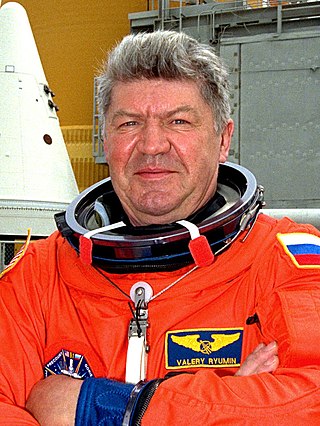
Valery Victorovich Ryumin was a Soviet cosmonaut.

Gennady Mikhailovich Strekalov was an engineer, cosmonaut, and administrator at Russian aerospace firm RSC Energia. He flew into space five times and lived aboard the Salyut 6, Salyut 7, and Mir space stations, spending over 268 days in space. The catastrophic explosion of a Soyuz rocket in 1983 led to him being one of only four people to use a launch escape system. He was decorated twice as Hero of the Soviet Union and received the Ashoka Chakra from India.
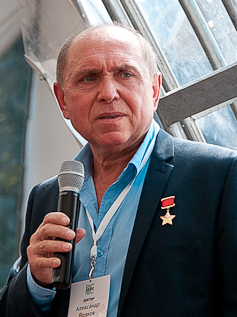
Aleksandr Aleksandrovich Volkov is a retired Soviet cosmonaut. He is a veteran of 3 space flights, including twice to the Mir Soviet space station, and is the father of cosmonaut Sergey Volkov.

Soyuz 30 was a 1978 crewed Soviet space flight to the Salyut 6 space station. It was the sixth mission to and fifth successful docking at the orbiting facility. The Soyuz 30 crew were the first to visit the long-duration Soyuz 29 resident crew.
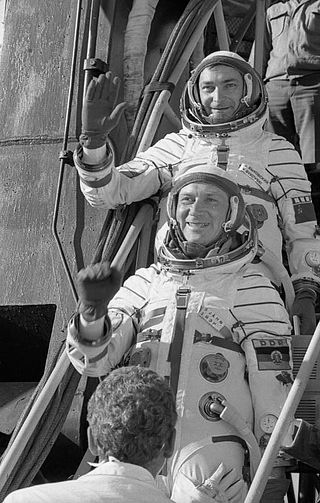
Soyuz 31 was a 1978 Soviet crewed space flight to the Salyut 6 space station. It was the seventh mission to and sixth successful docking at the orbiting facility. The Soyuz 31 crew were the second to visit the long-duration Soyuz 29 resident crew.

Soyuz TM-13 was the 13th expedition to the Mir space station. Launched from the Soviet Union in October 1991 and lasting until March 1992, the mission included cosmonauts from Austria and the Kazakh Soviet Socialist Republic, the latter of which became an independent state during the mission due to the dissolution of the Soviet Union in December 1991. The launch ceremony at the Baikonur Cosmodrome in Baikonur, Kazakh SSR was attended by the Soviet Premier Ivan Silaev, the President of the Kazakh SSR Nursultan Nazarbayev, and the Chancellor of Austria Franz Vranitzky. Before the launch, for the first time, President Nazarbayev received the launch report from cosmonaut Tokhtar Aubakirov in the Kazakh language.

Aleksandr Panayotov Aleksandrov is a retired Bulgarian cosmonaut. He is the second Bulgarian to have flown to space, behind Georgi Ivanov.

Vladimir Afanasyevich Lyakhov was a Ukrainian Soviet cosmonaut.
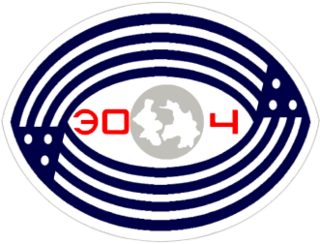
Mir EO-4 was the fourth long-duration expedition to the Soviet space station Mir. The expedition began in November 1988, when crew members Commander Aleksandr Volkov and Flight Engineer Sergei Krikalev arrived at the station via the spacecraft Soyuz TM-7. The third crew member of EO-4, Valeri Polyakov, was already aboard Mir, having arrived in August 1988 part way through the previous expedition, Mir EO-3.
Salyut 6 EO-1 was a Soviet long duration space expedition, the first to dock successfully with the space station Salyut 6. The two person crew stayed were in space for a record setting 96 days, from December 1977 to March 1978. The expedition was the start of what would be the semi-permanent occupation of space by the Soviets.
